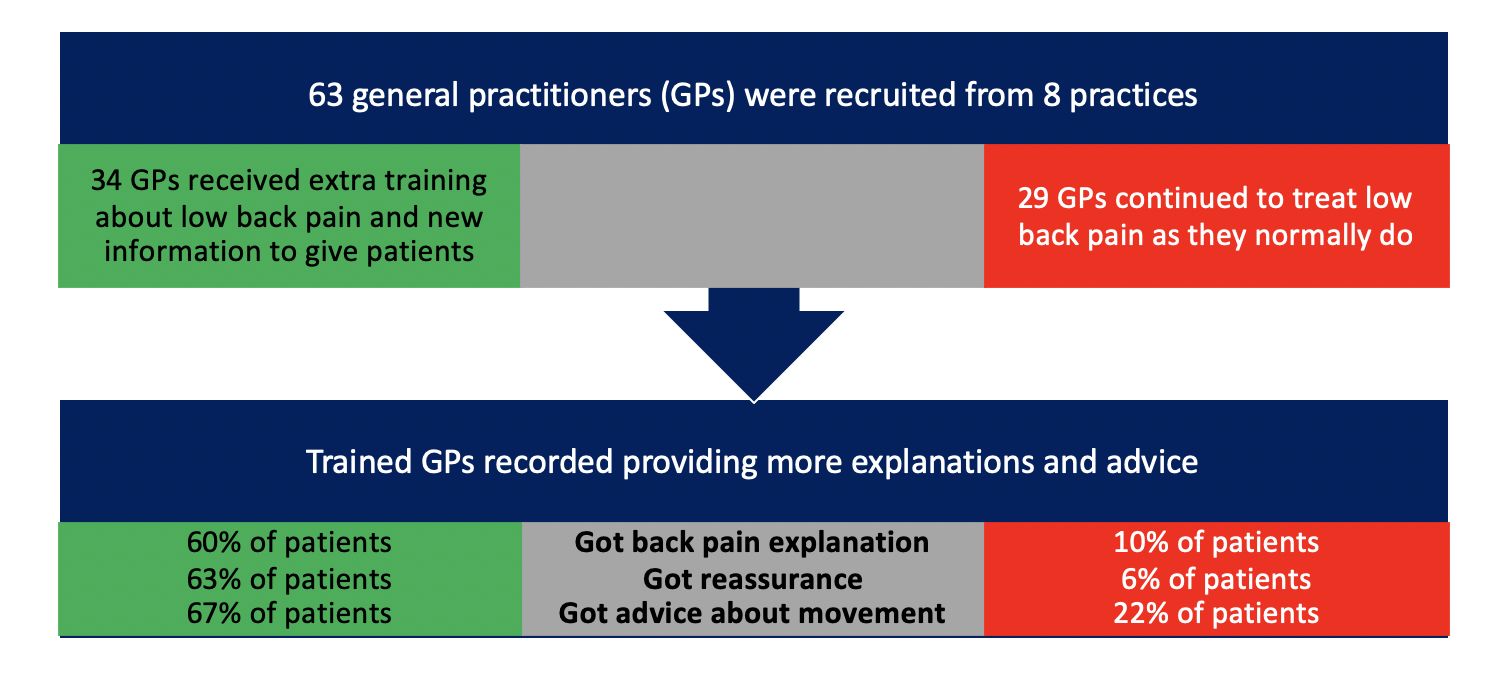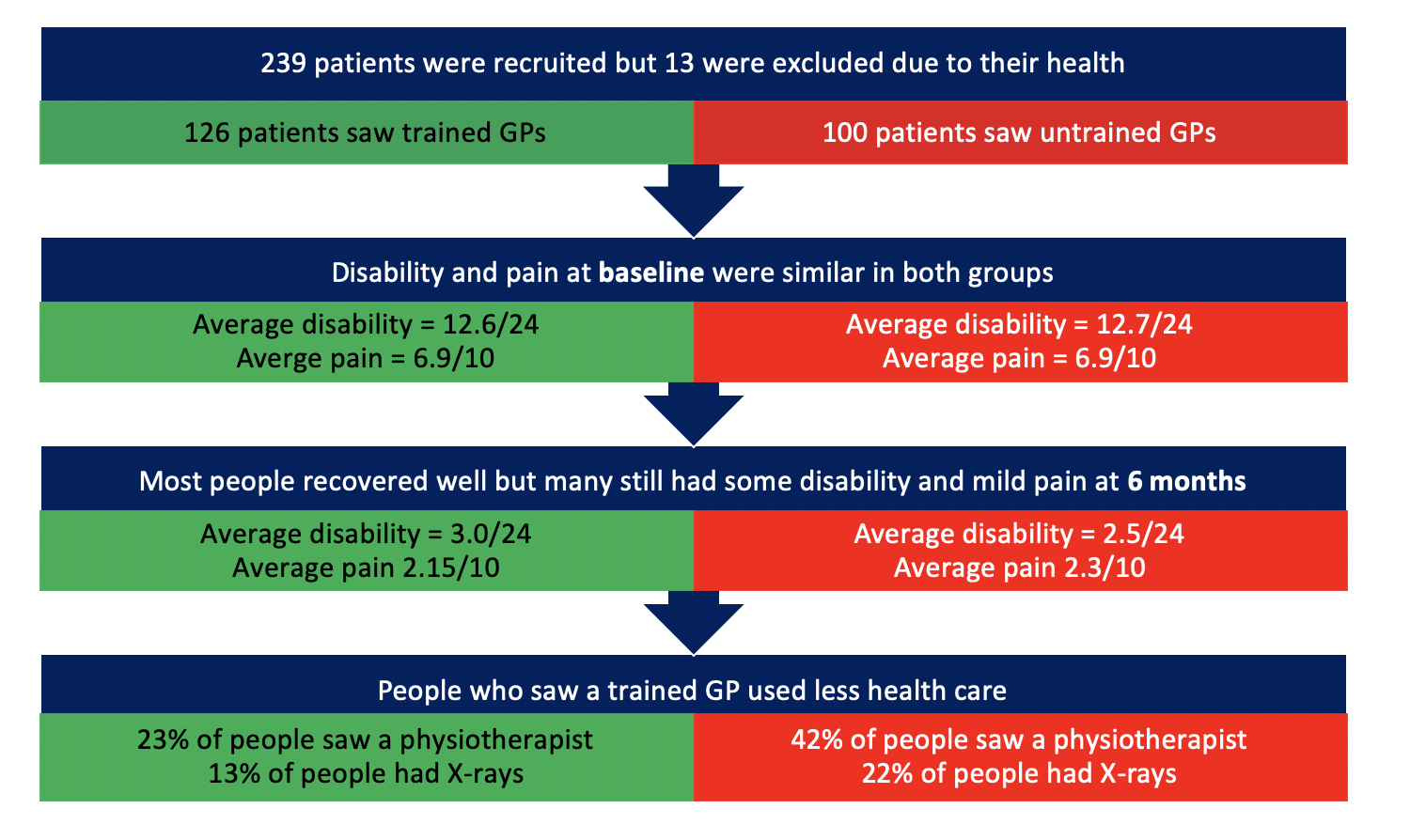By Ben Darlow (@BenD_NZ), on behalf of the Low Back Pain in General Practice Study research team (James Stanley, Sarah Dean, J. Haxby Abbott, Sue Garrett, Ross Wilson, Fiona Mathieson, Anthony Dowell)
People with back pain commonly visit their general practitioner (GP). As GPs are often the only primary care clinicians able to prescribe medication or provide work certificates, those with the highest levels of pain or disability are most likely to consult their GP.
A common view is that GPs do not add much value to back pain care, but in reality GPs are very good at supporting people to manage psychological and social influences on their health. As these factors are key predictors of recovery from back pain, we wondered whether we could empower and support GPs to use these skills to improve back pain recovery?
The FREE approach
We developed the Fear Reduction Exercised Early (FREE) approach to low back pain following exploration of patient beliefs1 2 and the impact of clinicians on these,3 4 as well as GP beliefs.5
The FREE approach restructures a normal GP consultation. FREE:
- shifts focus to exploring fears, beliefs, concerns and expectations and provides tools to positively influence these;
- highlights therapeutic opportunities within the consult;
- explains the rationale for guideline recommendations; and
- provides a framework for explaining back pain.
GPs are trained in the FREE approach through a four-hour workshop with a one-hour refresher after a month’s practice using it. They can then integrate FREE into their normal consultations.
The Low Back Pain in General Practice Study
We randomised eight general practices to the FREE approach (34 GPs) or usual care (29 GPs) and then recruited 226 patients who presented with low back pain (126 saw FREE trained GPs and 100 saw usual care GPs). We observed the initial consultation and followed these patients for 6 months.6 The results were recently published in PLOS Medicine.7
Following training, we saw significant and meaningful changes in GP attitudes, knowledge, and confidence to manage back pain. In addition, GP management of back pain became more aligned with best-practice guidelines. FREE-trained GPs were more likely to consider patient concerns, explain back pain, and provide reassurance and activity advice.
We were hoping that these changes in GP practice would improve patients’ recovery from back pain, however, both groups recovered similarly well. Notwithstanding this, those in the FREE arm received less health care (particularly less physiotherapy and a trend toward less imaging) and returned to work a little more quickly (although this change was not statistically significant). These changes meant that FREE dominated usual care in cost-effectiveness analyses.
We think these findings indicate FREE may improve GP contributions to back pain care, particularly their ability to reassure patients. This might reduce the health care burden placed on people while they recover – less time engaging in health care means less interference with normal lives and less exposure to harm.
Next, we plan to explore GP and patient perceptions of FREE, patient outcomes 2-years post-consultation, and whether FREE is appropriate to implement.
References
- Darlow B, Dean S, Perry M, et al. Easy to harm, hard to heal: patient views about the back. Spine 2015;40(11):842-50.
- Darlow B, Perry M, Dean S, et al. Putting physical activity whilst experiencing low back pain in context: balancing the risks and benefits. Arch Phys Med Rehabil 2016;97(2):245-51. doi: 10.1016/j.apmr.2015.09.020 [published Online First: 12 Oct 2015]
- Darlow B, Dowell A, Baxter GD, et al. The enduring impact of what clinicians say to people with low back pain. Ann Fam Med 2013;11(6):527-34. doi: 10.1370/afm.1518
- Darlow B, Fullen BM, Dean S, et al. The association between health care professional attitudes and beliefs and the attitudes and beliefs, clinical management, and outcomes of patients with low back pain: A systematic review. Eur J Pain 2012;16:3-17. doi: doi:10.1016/j.ejpain.2011.06.006
- Darlow B, Dean S, Perry M, et al. Acute low back pain management in general practice: uncertainty and conflicting certainties. Fam Pract 2014;31(6):723-32. doi: 10.1093/fampra/cmu051 [published Online First: 2014/09/07]
- Darlow B, Stanley J, Dean S, et al. The Fear Reduction Exercised Early (FREE) approach to low back pain: study protocol for a randomised controlled trial. Trials 2017;18(1):484. doi: 10.1186/s13063-017-2225-8
- Darlow B, Stanley J, Dean S, et al. The Fear Reduction Exercised Early (FREE) approach to management of low back pain in general practice: A pragmatic cluster-randomised controlled trial. PLOS Medicine2019;16(9):e1002897. doi: 10.1371/journal.pmed.1002897



